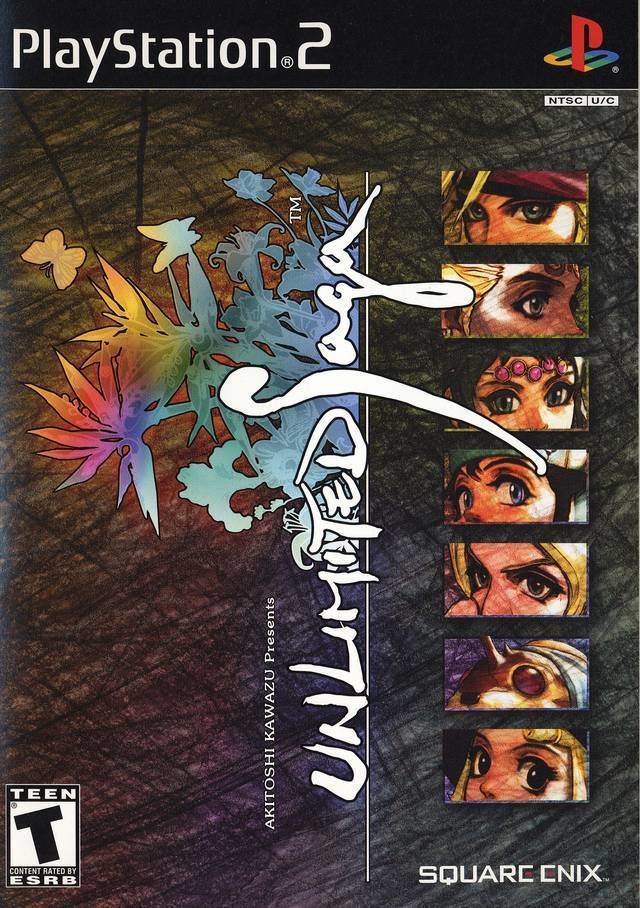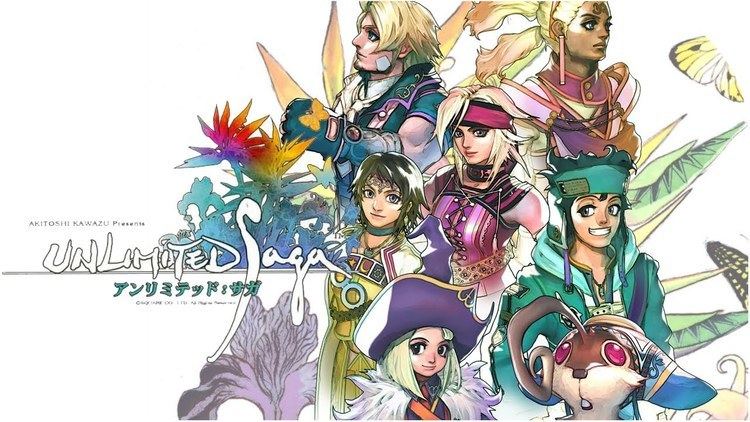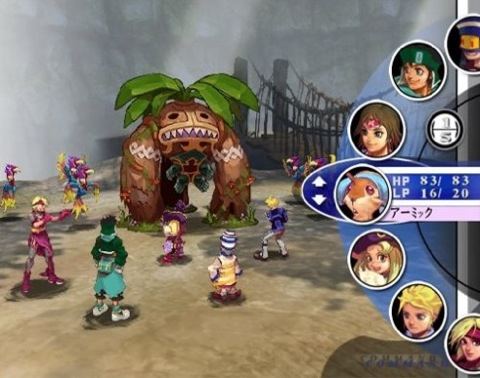5.2 /10 1 Votes
6.6/10 IGN Programmer(s) Takaaki Tonooka Initial release date 19 December 2002 Genre Role-playing video game | 45% Metacritic 45% GameFAQs Series SaGa | |||||||||||||||||||||||||||||||||
Publisher(s) JP: SquareNA: Square EnixEU: Atari Europe Writer(s) Jyunichi ShinomiyaMiwa ShodaAkitoshi Kawazu Similar SaGa games, Square Enix Holdings games, Role-playing video games | ||||||||||||||||||||||||||||||||||
Unlimited saga i like to video games unlimited saga
Unlimited Saga (アンリミテッド:サガ) is a role-playing video game developed and published by Square (later Square Enix) for the PlayStation 2 as the ninth game in their SaGa series. Originally released in Japan in December 2002, the game was later made available for North American players in June 2003 and in Europe the following October. The game was designed by series veteran Akitoshi Kawazu who is given a byline on the cover of the game's packaging, with music composed by Masashi Hamauzu who had previously provided the soundtrack for the game's predecessor, SaGa Frontier 2. A special limited collector's edition was made available exclusively in Japan and was released alongside the regular edition.
Contents
- Unlimited saga i like to video games unlimited saga
- Unlimited saga the tutorials episode 1
- Gameplay
- Plot
- Characters
- Development
- Reception
- References
Set in a fantasy world, the game follows the exploits of seven adventurers as they travel the world in search of the Seven Wonders, mysterious artifacts left behind by an ancient civilization that are said to bring about a new golden age of peace and prosperity when found. Taking a departure from previous games in the series, Unlimited Saga is structured more like a board game than a traditional role-playing endeavor, with heavily randomized features such as the roulette-like "Reel System" and hidden traps to hinder a player's progress.

Unlimited Saga was a commercial success, having sold over half a million units worldwide to date. While the game was mostly well received in Japan, it was largely panned by critics in North America and Europe for its unorthodox gameplay and high difficulty.

Unlimited saga the tutorials episode 1
Gameplay

Players must navigate their characters through a number of environments while completing story-based objectives in order to advance the plot. Players can assume the role of one of seven characters, each with their own strengths, weaknesses, and back stories, and become involved in the narrative by interacting with non-player characters and exploring dangerous areas. During the game, players will explore towns which can be used to gather information and purchase goods to aid them on their journey before setting off for the wilds. Unlike previous SaGa series games, rather than freely roaming through dungeons, forests, and other environments, the game is structured like a board game, referred to as the "Map Movement System", where players must move space by space to reach the end. On some spaces, the player may encounter objects such traps or locked doors that can be overcome by using the "Reel System", a device resembling a roulette wheel that may result in a good or bad outcome. While navigating the game board, the player will also encounter enemy monsters that must be defeated in order to advance.

Combat in Unlimited Saga takes place using a turn-based system where the player must input commands for each character individually, which are then carried out in order in accordance with their "speed" statistic. Parties can consist of up to five characters who are recruited either automatically as part of the story, or once a player has completed certain objectives. After selecting a specific attack to use each round, the player must then utilize the Reel System to randomly decide whether the action will take place. Depending on what icon the Reel lands on, an attack may land as intended, deal increased damage, or fail completely. While characters will initially have only a normal attack, they will randomly learn new combat skills based on their equipped weapon by continually attacking enemies, thus adding them to the Reel for a chance to use them in future battles. Any character may equip up to two different kinds of weapons, which have their own set of skills to learn. Players have the option to use multiple Reels instead of just one for a combo attack each round, allowing more than one character to attack an enemy at the same time. By winning battles, characters gain increased statistics that allow them to battle progressively more difficult enemies.
Plot

A god has awoken with the power of the "Seven Wonders of Lore", and has proclaimed a new golden age, and seven heroes set out to find out what this will mean.
Characters
Development
Unlimited SaGa was directed and produced by Akitoshi Kawazu, the creator of the SaGa series. The character designs and art direction were done by Yusuke Naora, who was the art director of Final Fantasy X. For the graphics, Square partnered with Adobe Systems to create "Sketch Motion" during battles. Using programs such as Photoshop and After Effects, hand-drawn 2D designs were combined with 3D models to create a unique hybrid look. As with other games in the series, director Akitoshi Kawazu chose a non-traditional way of designing the game. He stated, "As far as Unlimited Saga is concerned, we said let's tackle the basics of game design once again. We didn't try to emphasize the realistic details, but rather symbolize, and cut out the parts we didn't need. We thought, let's dare to do a 'not express' thing and we calmly [stuck] to that route."
The music was composed by Masashi Hamauzu, while synthesizer programming was done by Ryo Yamazaki. The two previously collaborated on the soundtrack for SaGa Frontier 2 after the departure of previous series composer Kenji Ito. Because the game uses streaming audio, it was possible for the sound team to use real acoustic instrument sounds in place of a synthesizer. Three pieces, including "March in C", were written for full orchestra. Live recording of ensembles of tracks such as "Feel Uneasy About the Wonders" and "Battle Theme IV" pitted solo instruments against one another to create what Hamauzu considered a Latin sound. The ending vocal piece "Soaring Wings" was written specifically for singer Mio Kashiwabara. Unlimited Saga features five-channel surround sound support from Dolby's Pro Logic II. The game's soundtrack consists of 58 songs spanning two discs. It was released on January 22, 2003.
Unlimited Saga: Limited Edition was released in Japan on the same day as the regular version of the game. It included a promotional Unlimited SaGa Maxi Single CD, a three-song CD. Unlimited Saga Collector's Edition was released in Europe and included a bonus DVD titled Eternal Calm Final Fantasy X-2: Prologue. A number of books were published by DigiCube, including Unlimited Saga: The First Guide Book for Beginners, a strategy guide; Unlimited Saga Material Collection: Lead to the Destiny, an artbook; and Unlimited Saga: Visual Arts Collection, a book containing CG images. Studio Bent Stuff also published a companion book. A set of postcards and posters was released by Square via its DigiCube distribution service. To promote Unlimited Saga in North America, Square Enix held the "Hall of Valor" contest beginning on the game's release date, June 17, 2003 and ending on July 27, 2003. It consisted of three challenges where players would have to send in answers to difficult questions related to the game. Prizes included products by electronics manufacturer Denon.
Reception
Unlimited Saga entered the Japanese sales charts at number 3 behind Pokémon Ruby and Sapphire, selling 196,471 copies, and ended the year with over 270,000 copies sold in Japan. By the end of 2003, Unlimited Saga had sold over 438,000 copies in Japan alone. By the end of Square Enix's fiscal year in May 2003, the game had sold 560,000 copies worldwide. For selling over half a million copies, Sony Computer Entertainment awarded the game a Gold Award during the 9th Annual PlayStation Awards on June 29, 2003. Unlimited Saga was scored a 31 out of 40 by Famitsu magazine, earning the publication's Silver Award. Prior to its release, Unlimited Saga was recognized by the Computer Entertainment Supplier's Association in its Game Awards Future category at the organization's annual event.
Unlimited Saga was not well-received outside Japan, receiving mostly low to average scores from critics. Electronic Gaming Monthly simply declared: "This game sucks. Unlimited Saga exemplifies everything that's wrong with RPGs today and throws it all together in one deluxe package for all to avoid like the plague." Official U.S. PlayStation Magazine largely agreed, stating that the game "ruined the SaGa franchise" with its "excruciating difficulty, obtuse mechanics, a stifling lack of freedom, and a brutal mission structure that punishes you as often as it rewards you." GameSpot called it "simply unpleasant to play", calling the gameplay "irksome" and remarking that "[t]he reel system is interesting in theory, but in practice it's just an annoyance". The website would additionally pan the game's "incredibly nonsensical" story and voice acting that ranges from "decent to really bad." IGN applauded the game's music and presentation, calling the game's audio "Unlimited Saga's most valuable asset", but found the rest of the game lacking, stating the "production values, character designs, and personable lead protagonists are a plus, but the clunky interface and lack of acceptable functionality hurt it - and hurt it bad." GamePro found the game generally lacking in quality, but declared its biggest hindrance to be its steep learning curve and non-linear story, finding that "[e]ven basic navigation is difficult in this game—it will take you an hour or two before you have any idea how to get anywhere." RPGamer called Unlimited Saga the "biggest letdown" of 2003 in their annual RPGamer Awards. The game maintains a 52% average score from aggregate review website GameRankings. GamesRadar called it the 25th Worst Game Of All Time.
